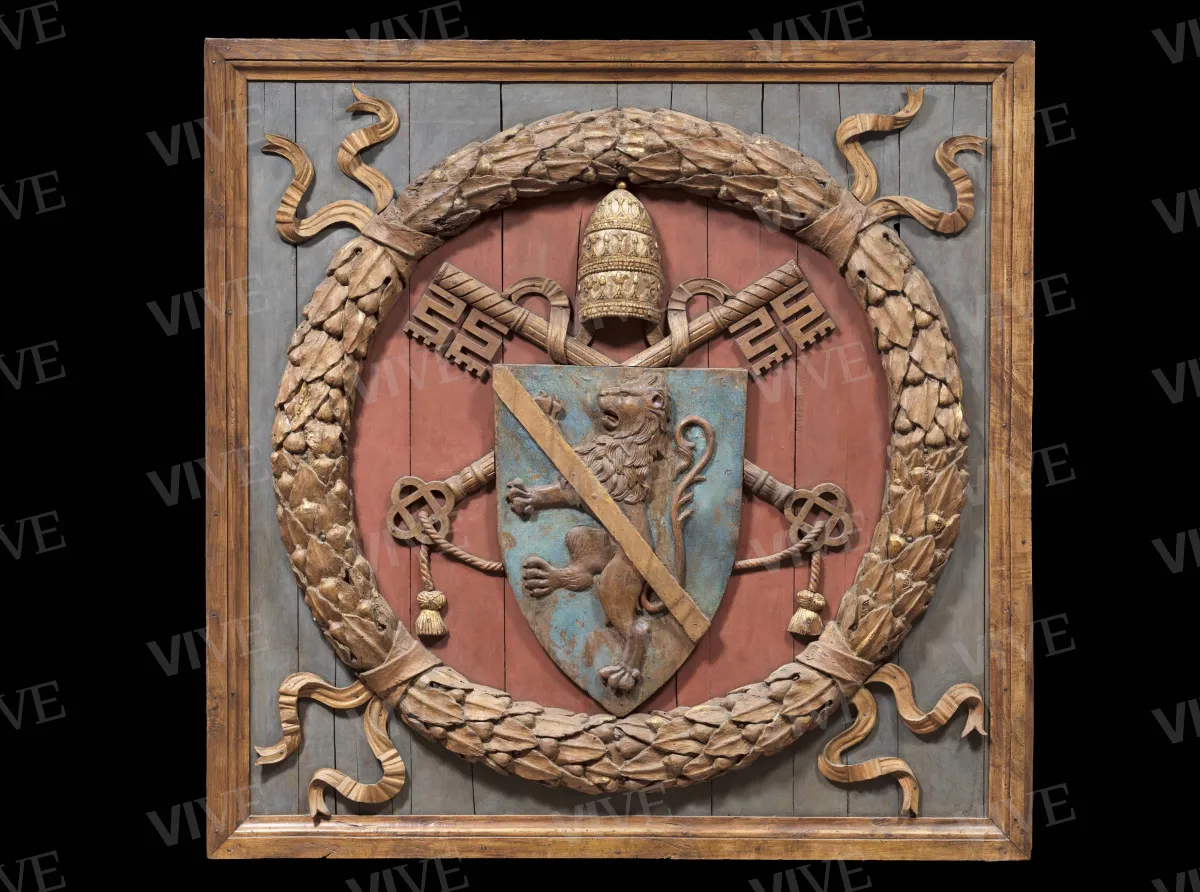Coat of arms of Pope Paul II
Giovannino de' Dolci 1467 circa
The coat of arms is one of the many papal insignia found carved, stuccoed, and painted in the corridors of Palazzo Venezia. It commemorates its patron, Venetian Cardinal Pietro Barbo, who later became Pope Paul II. Created by the Florentine carver and architect Giovannino de’ Dolci for the Sala del Mappamondo, it was likely removed when the hall was rebuilt in the eighteenth century.
The coat of arms is one of the many papal insignia found carved, stuccoed, and painted in the corridors of Palazzo Venezia. It commemorates its patron, Venetian Cardinal Pietro Barbo, who later became Pope Paul II. Created by the Florentine carver and architect Giovannino de’ Dolci for the Sala del Mappamondo, it was likely removed when the hall was rebuilt in the eighteenth century.
Details of work
Catalog entry
The coat of arms represents the papal arms of Pope Paul II. Born in 1417 into a notable family of the Venetian Republic, Pietro Barbo was a nephew of Pope Eugene IV, who placed him at the papal court. His ecclesiastical career led him to obtain the cardinalate at the age of twenty-three in 1440. After being titular of Santa Maria Nuova, he became titular of San Marco in 1451 and initiated the renovation of the basilica and its adjoining palazzo, now a museum. When he became pope on August 30, 1464, Paul II promoted a campaign of architectural and urban renewal in Rome, with the Palazzo Venezia and basilica of San Marco serving as examples. In this palazzo, the pope also kept his collection of antiquities, including works such as the Hellenistic cup decorated in relief, known as the Tazza Farnese, which is now in the Museo Nazionale Archeologico in Naples.
Encircled by an ornate laurel wreath adorned with four flowing ribbons, the coat of arms is positioned over two large crossed keys, which, along with the tiara, symbolize papal authority. The shield, now bluish in hue, features a rampant lion traversed by a golden band. The current color scheme, modified over time and through subsequent restorations, only partially reflects the original family heraldry, which can still be observed on the coats of arms on the ceiling of the basilica of San Marco. These original colors include azure for the background, gold for the band, and silver, initially designated for the lion. A restoration undertaken in the 1970s revealed substantial additions, visible to the naked eye, to the keys, the cords, the ribbons of the garland, and the lion’s right paw. The woods employed in the construction of the piece are poplar for the coat of arms and garland, and chestnut for the background.
The coat of arms, initially part of the original decoration of the lacunar ceiling in the Sala del Mappamondo at Palazzo Venezia, was likely removed when the room was redecorated by the Venetian ambassador Nicolò Duodo (1657–1742) in the early eighteenth century. It was rediscovered in 1917 during the building's restoration. Federico Hermanin proposed placing it above the Bust of Paul II (inv. 4057) in the second room of the Barbo apartment, as recorded in a drawing from 1921 (Nicita 2009). Photographs from a later installation show that by 1927, it had already been relocated to the Room of the Labors of Hercules.
The work is likely attributed to Giovannino de’ Dolci, a Florentine carver and architect who was involved in the construction of the basilica and the papal palace of San Marco. Alongside his brother Marco, he carved the wooden ceiling decorations, which were painted by Giuliano degli Amedei and completed by 1469. Payments for eight coats of arms with garlands or festoons (octo arme cum la festa incontro intagliata) were made to the artist following the death of Paul II (Frommel 2006, p. 218).
The coat of arms serves as a monumental representation of the numerous papal insignia that are sculpted, stuccoed, and painted within the corridors of Palazzo Venezia. As symbols of papal presence and authority, they establish continuity between the ceiling of the small palazzo and that of the basilica, effectively integrating the latter into Paul II’s residence.
Matteo Chirumbolo
Entry published on 27 March 2025
State of conservation
Good.
Restorations and analyses
1978: restoration by Anna Maria Gnocchi Ziegler, under the supervision of Maria Vittoria Brugnoli.
Provenance
Formerly in Palazzo Venezia.
Exhibition history
Rome, Museo di Palazzo Venezia, Paolo II e le fabbriche di San Marco, May–September 1980;
Florence, Uffizi Galleries, I cieli in una stanza. Soffitti lignei a Firenze e a Roma nel Rinascimento, December 10, 2019–March 8, 2020.
References
Casanova Uccella, in Casanova Uccella Maria Letizia (a cura di), Palazzo Venezia. Paolo II e le fabbriche di San Marco, catalogo della mostra (Roma, Museo di Palazzo Venezia, maggio-settembre 1980), Roma 1980, p. 20, n. 1 (ill.);
Frommel Christoph Luitpold, Palazzo Venezia, Palazzetto di Venezia e San Marco, in Frommel Christoph Luitpold, Architettura e committenza da Alberti a Bramante, Firenze 2006, pp. 157-309;
Nicita Paola, Musei e storia dell’arte a Roma. Palazzo Corsini, Palazzo Venezia, Castel Sant’Angelo e Palazzo Barberini tra XIX e XX secolo, Roma 2009;
Pittiglio, in Barberini Maria Giulia, Sconci Maria Selene (a cura di), Guida al Museo Nazionale del Palazzo di Venezia, Roma 2009, p. 23, n. 3 (ill.);
Martone, in Conforti Claudia, D’Amelio Maria Grazia, Funis Francesca, Grieco Lorenzo (a cura di), I cieli in una stanza. Soffitti lignei a Firenze e a Roma nel Rinascimento, catalogo della mostra (Firenze, Gallerie degli Uffizi, 10 dicembre 2019-8 marzo 2020), Firenze 2019, p. 82, n. 5.












